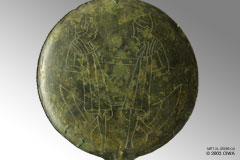Engraved mirror, Etruria, 300 BC

Links to other views:⇒ Larger View⇒ Front ⇒ Back if scripting is off, click the ⇒ instead. Links to others of type MirrorBronze mirror, double Horus, Dyn. 12Bronze Mirror, Rome, 50 BC-50 AD Copper and wood mirror, Dyn. 8 Engraved bronze mirror, Persia, 1100 BC Engraved mirror, Etruria, 380 BC Engraved mirror, Etruria, 400-300 BC Hammered bronze mirror, Persia, c.1000 BC Mirror, Amlash, Persia, 1100-900 BC Mirror with long handle, Etruria, 400 BC |
The reverse side of this Etruscan mirror is engraved with a scene of two people conversing. The “mirror side,” smooth and convex, is edged by a deeply incised border. The handle ends as a swan’s beak, as with number 353- Palestrina at the “Museo Nazionale di Villa Giulia” in Rome. “Engraved bronze mirrors were an Etruscan specialty, from the sixth to the second century BC. On the reverse side, they were decorated with various motifs: botanic or figured, sometimes raised. These toiletry items were intended for a female audience, which influenced the selection of motifs.” (Thuillier 1995:40-41) Etruscans The Etruscan (or Tusci) civilization was a short-lived but original, sophisticated and influential civilization that developed in the region of northern Italy still known today as Tuscany. Following the Villanovian culture of the ninth century BC, the Etruscan culture emerged around 800 BC among the indigenous population, with perhaps some influence from the East. The Etruscan language is still poorly understood. Although the writing symbols are similar to the Greek alphabet, the words of the language are like no other. Although we speak of Etruria as if it were a nation, it was really no more than a set of cities and city-states with a common culture. Although Roman historians describe a “council” of twelve Etruscan cities, we have no idea what was the purview of the council, and there is little evidence left of any concrete political entity. With a long coastline rife with natural harbors, and a back country rich with copper and iron ore, Tuscany was well suited to the development of both technology and commerce. The Etruscans excelled in both. Etruscan art and techniques were greatly influenced by the Greek World, yet preserved their own distinctive character. At their heyday, Etruscan metal craftsmen had no equal anywhere in the ancient world, and their wares were highly prized all over the Mediterranean. Etruscans also excelled in public works. Despite their lack of a central government, they built a spectacular network of roads, bridges, and viaducts. They developed a clever system for improving the drainage of their lands and controlling the levels of their lakes. They also built remarkable cities, temples and tombs. Etruscans had a complex religion and a deep concern for the afterlife that led them to build chamber tombs, replicating underground the dwellings of the living. It is from those tombs, their decorated walls, and the vast amounts of material cultural goods (much of them imported) the tombs contain that we have learned most of what we know about Etruscans. Etruscan prosperity declined sharply during the fourth century, as other powers blocked their trade routes: southward with their complete naval defeat against the Greeks at Cumae in 474 BC on the Mediterranean side; northward with the progressive takeover of their outposts in northeastern Italy on the Adriatic. But in the long run it is Rome, a city-state of Latin people deeply influenced and infiltrated by Etruscan families at the highest levels of power, that would gradually absorb the cities of the Etruscan culture. By 100 BC, Etruria had become completely assimilated into the Roman world it had helped educate. Bibliography (for this item)Anlen, Léon, and Roger Padiou1989 Les miroirs de bronze anciens. Guy Tredaniel, Paris, France. Bianchi Bandinelli, Ranuccio, and Antonio Guiliano 1973 Les étrusques et l’Italie avant Rome. Gallimard, Paris, France. (214 plate # 249 262 plate # 300 305 plate # 353,354) Rebuffat, Denise 1977 Les miroirs étrusques: Les deux faces des miroirs, vanités perdues et images gravées. Dossiers de l’Archéologie, 24:88-96. Thuillier, Jean-Paul 1995 LES ETRUSQUES, la fin d’un mystère. Gallimard -Découvertes-, Paris. ( 40-41) Bibliography (on Etruscans)Tait, Hugh1991 Jewelry: 7000 Years: An international History and Illustrated Survey from the Collections of the British Museum (republication of the 1987 edtion by H. N. Abrams). Abradale Press, New York, NY. |